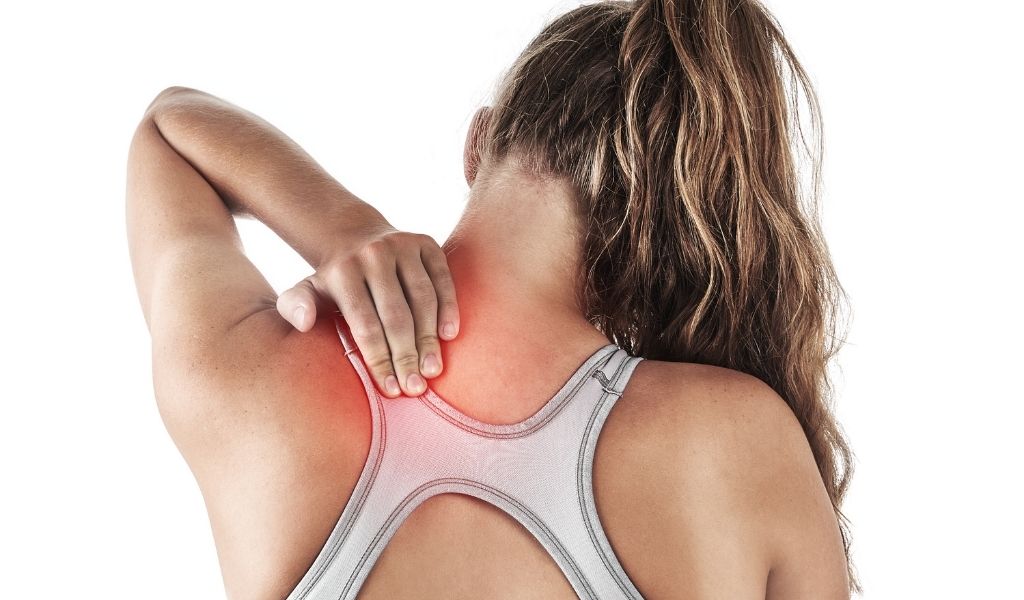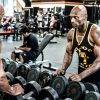6 Brilliant Ways To Relieve Sore Muscle After Workout
You’re struggling to breathe. Your face is red with determination. You finally finish the last repetition. The beads of sweat roll down your body like rain droplets. You stand up from the machine and suddenly you feel the consequences of the work you have just done to your body. Your ankles have cinder blocks attached to them as you shuffle from the machine to the door; you think,“I’m so tired, I can’t stay any longer” … “I’ll stretch at home”(but you never do)… “Is it even really that important?” Yes, yes it is. If you neglect your muscle recovery, the only person you’re hurting is you.
The first part of your warm-up should include some form of cardiovascular work to elevate the heart rate ever so slightly. A quick 5-10 minute walk, elliptical, or biking session are all great ways to get the whole body prepared for the next stage. Once you get your blood flowing all over, it is time to do some body weight or banded exercises that will mimic, or at least work the same muscles as the movements you plan to do during the bulk of your workout.
You only have one hour until your next meeting… you don’t want to hit traffic picking the kids up from daycare…there’s just 30 minutes until The Bachelor comes on. It is tempting to just get straight to business at the gym when you’re on a tight schedule. Priming the muscles is a crucial step, however, and if you aren’t currently practicing it, you’re missing a slew of benefits. Doing something as little as some body weight squats before jumping right into your one maximum repetition can direct blood and oxygen flow to the cells and their systems in your glutes, quadriceps, hamstrings, calves, and core. Rather than shocking the body and immediately loading 300 pounds on the bar, a few sets of ten to twelve repetitions without any weight can help ease muscle and joint stiffness and create a safe environment within the body to gradually increase intensity. Doing simple, low intensity movements can help one to identify and adjust any problems with form, or pinpoint a specific sore spot for foam rolling or massage therapy. Dedicating the time to properly prepare the body ensures that you will reap the maximum benefits from your most difficult and physically taxing lifts. Let’s take a look at some specific examples of dynamic movement that can help you.
Like I mentioned, a bodyweight squat is a great tool for leg days. Other examples of exercises to include in a leg day warm up are:
– Hip hinges
– Forward or reverse lunges
– Cat-cow
– Tabletop to child’s pose
– Glute bridges
– Supine 90 degree leg lowers
You’ll notice, the muscles of the core and abdomen are the main movers for some of these exercises. Stabilizing and working the core prior to performing a conventional deadlift, for example, can help the mind create that connection to the muscle and familiarize itself with the inner mechanics of bracing and flexing the core. Thus, benefitting the body in the long run because it’ll be less prone to an injury, such as a slipped disc. Much like regular oil changes ensure the longevity of your vehicle, regular and consistent warm ups that include a few core exercises help ensure there is less of a chance of injury.
Now that we know what a lower body warm up can look like, what can you do to send blood and oxygen to the upper body? Here’s a list of exercises to perform before your next back and biceps day. Two to three sets of 10-12 repetitions each should be enough to prepare for the bulk of your lift:
– 5s. Superman holds
– Prone W to Y press
– Downward dog to plank
– Downward dog push up
– Hip hinges
– Resistance band bent over row
– Resistance band bicep curl
Once you have accomplished a small bout of cardiovascular work, a few movements that correspond with our main lifts of the day, and core exercises during the warm-up, it is safe to move on to the “meat and potatoes” of our workout. It’s time to finally get to work and start really moving around.
This part of the session is typically where we do the most damage to the muscle. That’s right, as you lift weights, do plyometrics, or whatever
else is on your program, you’re actually creating microtears in your muscle that your body must then repair, hence why we feel sore! Pro-tip: think “less is more” when it comes to the bulk of your session. You don’t need to do three sets of eight different exercises. In a set and repetition range that is relative to you and your goals, four to five different movements that target all of the muscles in that specific group is just enough. Focus on the quality and control of your movement, and remember to connect with the breath throughout it all.
Continuing with our car theme, think of your cool down like parking your car. You don’t just take your keys out of the ignition and hope for the best. No, you have to slow down, find a spot, pull in, shift to park, and then you can take the key out and go on your way. See, just as our cars release carbon dioxide gas into the air, your muscles also produce what’s known as “lactic acid” into the bloodstream during exercise. This acid can cause cramps and muscle soreness if not properly taken care of. A great way to get blood flow to areas that would be prone to lactic acid build up (i.e the quadriceps on a leg day, latissimus dorsi on a back day) is by performing a short and slow five to ten minute bout of cardiovascular exercise followed by some static stretching. Static stretching is preferred at the very end of the workout because after spending 30 minutes to an hour or so of contracting with force, it’s important to take the time to lengthen and send oxygen via your breath to the muscles. Below are two examples of a cool down portion of both an upper body and a lower body lift. You’ll want to spend 30 seconds to 1 minute in each position.
– Seated toe reach
– Seated figure four stretch
– Pigeon pose
– Happy baby
– Standing quadricep stretch
– Standing hamstring stretch
– Deep squat stretch
– Child’s pose
– Cat-cows
– Cross-body shoulder stretch
– Ear to shoulder stretch
– Behind the back chest stretch
– Doorway chest stretch
We’ve all been there. You get a little too carried away at the gym and the next day you wake, knowing it will be a battle just to get up and out of bed. How could exercise, something that is supposed to be so good for you, make you feel so much pain? It’s called Delayed Onset Muscle Soreness, or D.O.M.S. for short, and it usually occurs 24-48 hours after exercise. As a result of exercise and creating those microtears in the muscles, the body has this inflammatory response, causing muscle stiffness and soreness, in turn limiting the muscle’s range of motion. That’s why your short step to the
bathroom in the morning after a leg day may feel like a marathon. Let’s talk about ways to help alleviate these symptoms and speed up the recovery process.
In a 2014 study done by the American College of Sports Medicine, the scientists found that foam rolling “substantially reduced muscle soreness at all time points while substantially improving ROM”(range of motion).
Specifically, their evidence concluded that foam rolling was proven to have a profound effect when it came to just how quickly the connective tissue surrounding the muscle repaired. The best part is, these foam rollers are easily accessible(you can find them in practically every sporting goods store nowadays!), generally pretty light weight, and relatively inexpensive.
3. Cryotherapy
A method that leaves peculiar looking marks on the body, this type of treatment has gained recognition for many reasons. Cupping originated as a means of stimulating the flow of energy, or “Qui”, around the body. Actually an ancient chinese medicine technique, the Asian Journal of Kinesiology and a study done by Texas A&M professionals found ‘there is evidence to show that dry cupping can increase microvascular function [41] thereby promoting blood and lymphatic flow with negative pressure from suction, which causes stretching of the skin and underlying tissue as well as dilation of the capillaries”. By strategically causing blood to flow to the muscle via cupping, it’s been proven to decrease muscle soreness.
Engineering did a study on the practice spanning over 2 years, and they found that not only was acupuncture effective in treating muscle soreness, but it also decreased serum creatine kinase levels. Creatine Kinase is a type of enzyme that is found in our muscles,heart, and brain. When damage or injury occurs to these tissues, they secrete this creatine kinase, and according to this study acupuncture can help mitigate it. Because each session stimulates the whole central nervous system, acupuncture has also been known for its holistic healing benefits as well. If you’re not afraid of needles, this may be the muscle recovery method for you!
Lastly, and maybe the most obvious, it is possible to treat your muscle soreness through what you are consuming. If you’re not paying enough attention to what you’re eating, you could be at risk for not fueling your body properly. If you find yourself constantly feeling fatigued or sore after a workout, it may be time to increase protein or calorie intake. Though specific recommendations vary from person to person, the American College of Sports Medicine (A.C.S.M.) says protein should account for 20 to 30 percent of one’s daily caloric intake. A carbohydrate-heavy meal should be consumed prior to working out to ensure that glucose is readily available in the bloodstream for the body to use. Not only is exercising in a fasted state potentially dangerous, but it can actually cause more protein loss within the muscle. The protein we eat contains amino acids, which are the essential building blocks for new muscle. The A.C.S.M. also states that, “protein ingestion following an acute bout of resistance training stimulates muscle protein synthesis for up to three hours. In contrast, failing to eat after exercise may limit protein synthesis and
therefore limit potential progress in lean muscle tissue development.” So if you are hoping to get the most out of those squats and deadlifts, make sure you are fueling your body properly. After all, our bodies are just like cars, we need the right gas and a full tank to get us moving.
References:
MacDonald, Graham Z.1; Button, Duane C.1; Drinkwater, Eric J.1,2; Behm, David George1 Foam Rolling as a Recovery Tool after an Intense Bout of Physical Activity, Medicine & Science in Sports & Exercise: January 2014 – Volume 46 – Issue 1 – p 131-142
doi: 10.1249/MSS.0b013e3182a123db
Martin, J. (2021, January 20). A critical evaluation of percussion massage gun devices as a rehabilitation tool focusing on lower limb mobility: A literature review. https://doi.org/10.31236/osf.io/j9ya8
Snyder, J. G., Ambegaonkar, J. P., & Winchester, J. B. (2011). Cryotherapy for Treatment of Delayed Onset Muscle Soreness, International Journal of Athletic Therapy and Training, 16(4), 28-32. Retrieved May 18, 2022, from https://journals.humankinetics.com/view/journals/ijatt/16/4/article-p28.xml
Smith, J., Morrison, A., & Villarreal, M. (2021, October 31). Texas A&M University-San Antonio Digital Commons @ Texas A&M University … Retrieved May 19, 2022, from
https://digitalcommons.tamusa.edu/cgi/viewcontent.cgi?article=1002&context=ps yc_faculty
The American College of Sports Medicine. (2015). Protein intake for optimal muscle maintenance – ACSM. Retrieved May 19, 2022, from https://www.acsm.org/docs/default-source/files-for-resource-library/protein-intake -for-optimal-muscle-maintenance.pdf?sfvrsn=688d8896_2
The post 6 Brilliant Ways To Relieve Sore Muscle After Workout first appeared on MO Marketplace and is written by MO Team




